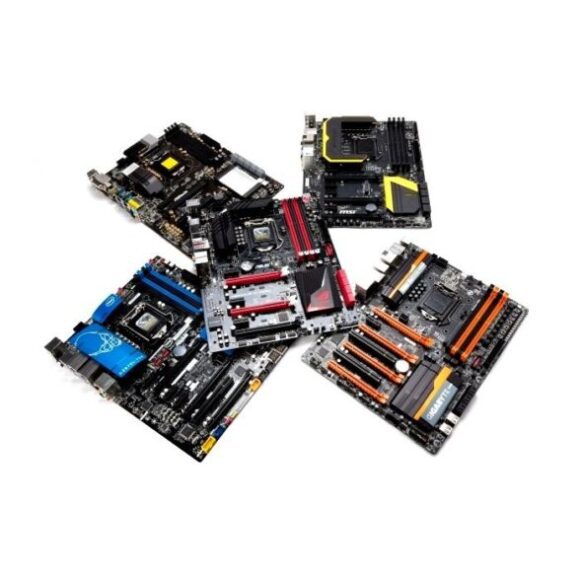
Guide to Computer Motherboard
The computer motherboard is a critical component of any PC, acting as the backbone that connects all other elements and allows them to work together seamlessly. It is a complex circuit board that provides electrical pathways and communication infrastructure for a variety of components, such as the processor, memory, storage, and peripheral devices. In this complete guide, we’ll get into the world of computer motherboards, covering everything you need to know about this critical piece of hardware. From understanding what a motherboard is and its key components to selecting the best one for your needs and troubleshooting common problems, we’ve got you covered, so whether you’re building your PC, looking for computer motherboards for sale, or simply curious about how your machine works, read on to become a motherboard expert!
What is a Motherboard?
A motherboard, also known as a mainboard or system board, is the central component of a computer system. It provides the physical platform and electrical connections required for the various computer components to communicate and function together. The motherboard houses critical components such as the processor (CPU), RAM, storage devices, and expansion cards. It also makes it easier to transfer data and power between these devices, ensuring that they work together seamlessly. Simply put, the motherboard is your computer’s heart and soul, determining its functionality and performance potential.
Computer Motherboard History in Brief
From its early days, the development of the computer motherboard has progressed strongly. This is a simplified history of its evolution:
The Initial Years (1970s–1980s)
With the introduction of the S-100 bus and devices such as the Altair 8800, the idea of a motherboard as we know it now became a parent. These early motherboards featured basic integrated components and restricted growth capabilities.
1980s–1990s IBM AT Era
A big development was made in 1984 with the introduction of the IBM AT (Advanced Technology). It brought the AT form factor and the 16-bit ISA bus, which changed motherboard and PC design.
Standardization and Growth (1990s–2000s)
Form factors, bus architectures, and peripheral connectivity all saw the introduction of industry standards in the 1990s. Since its introduction in 1995, the ATX form factor has gained popularity due to its improved flexibility and power management.
Modern Innovations from the 2000s Onward
Developments like support for faster processors, larger capacity memory, and high-speed interfaces like USB and SATA came with the new century. The requirement for extra expansion cards declined when motherboards incorporated networking, audio, and even some graphics processing.
The Most Important Components of a Motherboard
There are several essential components that make up a common motherboard, and each of these components serves a specific purpose.
Here are the most important aspects that you need to be aware of:
Processor Socket or Slot
This is the location where the central processing unit (CPU) and other elements are installed. Specific processor types are compatible with a particular type of socket, which determines compatibility. Common examples include the Land Grid Array (LGA) socket used by Intel and the AM4 socket used by AMD.
Slots for Memory
Memory modules, also known as RAM sticks, are installed in these slots, which are also referred to as DIMM slots or RAM slots. They decide the kind of memory and the amount of memory that your system is capable of managing.
Expansion Slots
These slots are designed to accommodate the installation of expansion cards, which may include graphics cards, sound cards, or network adapters. PCI, PCI Express (PCIe), and the older AGP slots are some examples of other types of slots.
Chipsets
The Northbridge area and Southbridge (or their modern equivalents) are elements that make up the chipset of the motherboard. Managing the flow of data between the processor, memory, and accessories is the responsibility of these chips, which determine the capabilities of the system.
BIOS/UEFI Chip
This chip stores the software for either the Basic Input/Output System (BIOS) or the Unified Extensible Firmware Interface (UEFI), which is responsible for initializing the hardware and making the boot process easier.
Connectors for Power
Motherboards are equipped with power connectors that are able to receive power from the power supply unit (PSU) and then distribute it to the central processing unit (CPU), memory, and other components.
Connectors for Storage
These connectors, which include such things as SATA or M.2 slots, make it possible to connect storage devices such as solid-state drives (SSDs) or hard drives.
Input/Output Ports
Motherboards offer a variety of input/output ports that can be used to connect various accessories. These ports include USB, Ethernet, audio jacks, display ports (such as HDMI and DisplayPort), and legacy ports such as PS/2.
Internal Components
A great number of motherboards incorporate extra elements directly into their design. These components include audio encoders, network adapters, wireless modules (Wi-Fi/Bluetooth), and basic graphics processing units (GPUs).
Different kinds of Computer Motherboards
There are a variety of forms of motherboards, and each one is made for a particular purpose:
ATX
ATX is a popular motherboard form factor because it doesn’t take up too much room and can be expanded. Its 12″ by 9.6″ dimensions are usually found on desktop PCs, where it offers lots of expansion spaces and I/O ports.
MicroATX
The microATX standard is a smaller version of ATX. MicroATX systems are 9.6″ by 9.6. They are small but can still be expanded, which makes them perfect for systems with a smaller form factor.
Mini-ITX
The smallest systems are mini-ITX boards, which are only 6.7″ by 6.7″. They are made for systems that don’t have a lot of room, like home theater PCs or small game rigs.
EATX
EATX stands for “Extended ATX.” The EATX motherboards are up to 12″ by 13″ bigger than standard ATX motherboards. They add more expansion options for high-end workstations or game computers.
Motherboards for Servers and Workstations
For server or workstation environments, these motherboards are made to handle multiple processors (two or more), large amounts of memory, and enterprise-level storage options.
Proprietary Motherboards
Some computer makers use special motherboard designs that are made just for their products. These motherboards have different form factors and connector arrangements.
Choosing the Right Motherboard for PC
Take into consideration the following important aspects when choosing a motherboard for your personal computer:
Compatibility
Make sure that the motherboard is compatible with the processor and memory that you have selected. Check the type of socket, the type of memory, and the speed, in addition to any specific requirements that may be imposed on other components.
Form Factor
Select a form factor which is suitable with the size of your case while also providing the expansion capabilities that are required for the configuration of your system that you want to achieve.
Features and Connectivity
Inspect the I/O ports, storage connectors, onboard audio/networking capabilities, and expansion slots of the motherboard to determine whether or not they are suitable for your requirements regarding connectivity and features.
Performance and Overclocking
If you intend to overclock, you should look for motherboards that are specifically designed for use with overclocking. These motherboards should provide enhanced power delivery systems as well as advanced BIOS/UEFI options.
Price and Brand
Consider your budget, as well as the level of performance and features that you require, when making your purchase decision. Parts of higher quality and an improved level of technical support are typically provided by well-established brands.
Solving Typical Motherboard Problems
Motherboards can have problems. The following are some typical issues and solutions for them:
Not Booting System or No Display
Make sure the RAM and CPU have settled correctly, check the power connections, and do a hard reset.
Problems with the BIOS or UEFI
Reset the BIOS to its original settings by clearing the CMOS/BIOS settings by taking out the CMOS battery for a short while.
Hardware Incompatibility
Verify that your motherboard is compatible with the hardware, and consult the handbook for detailed installation instructions.
Burnout and Short Circuits
External damage, like spilling liquids or electrical surges, can lead to motherboard failure. Take caution when handling the motherboard and shield it from electrostatic discharge (ESD).
USB or Accessory Ports that are Malfunctioning
To isolate the problem, try connecting devices to different ports or using different cables. If several ports fail, there might be a motherboard issue.
Beep Codes
During the boot process, keep an ear out for beep codes. These codes signify particular problems with the motherboard or other parts. See the handbook that came with your motherboard for clarification.
Prospects for Motherboard Technology in the Future
Here are a few prospective developments in motherboard technology for the future:
Miniaturization and Enhanced Integration
As motherboards get smaller, more features will probably be integrated, which will cut down on the need for expansion cards. Form factors will get even smaller as a result of miniaturization.
Improved Performance and Power Efficiency
Faster CPUs, larger memory capacities, and more effective power delivery systems will all need to be supported by motherboards.
Innovations in Wireless and Connectivity
You can anticipate support for more recent connectivity standards like USB4 and Thunderbolt, as well as cutting-edge wireless technologies like Wi-Fi 6/6E and Bluetooth 5.0.
Automation and Artificial Intelligence
AI will be more prevalent in motherboard design, allowing for predictive failure analysis, automated system optimization, and improved security.
Modular Design and Customization
More modular motherboard designs enable users to upgrade individual parts or sections for increased durability and personalization.
Conclusion
Being the primary element of modern computing systems, the motherboard is an intriguing technological advancement that has undergone substantial development. We hope that this guide has given you important knowledge about motherboards, including types, elements, and important factors to keep in mind when making a decision. Whether you’re a tech enthusiast, gamer, or just interested in technology, knowing about motherboards will allow you to efficiently build, update, and troubleshoot your own systems. While looking for computer motherboards for sale, keep in mind your unique requirements and financial constraints. To ensure you make an informed choice, you should constantly consult reputable sources and reviews. Have fun with computing!
You might also want to take the following for consideration as you research computer motherboards:
- What motherboard do i have? Use system information tools or check the documentation that came with your computer if you have questions about the model or specifications of your current motherboard.
- The brand, features, and performance of a motherboard can all have a big impact on the price. It’s important to establish a spending limit and compare prices to get the best deal for your requirements.
- For servers or workstations that need the processing power of multiple CPUs, dual CPU motherboards are designed. Generally speaking, they cost more and are bigger than ordinary motherboards.
Visit us more: tribuneinsights.com
Visit us more: tribuneinsights.com
Recent Posts
Understanding the Challenges of Communicating with Seniors Living with Dementia
The Benefits of Marketing Automation for Small Businesses
Exploring Bee Behavior and Hive Structures What Makes a Hive Attractive to Bees?
All Categories
- Apps
- Asian Games
- Auto
- Banking
- Beauty
- Blog
- Cricket
- Cricket
- Cryptocurrency
- Economy
- Education
- Fashion
- Fitness Zone
- Football News
- Gadgets
- Health
- Industry
- Interviews
- IPL
- Job & Feed
- Life Style
- Markets
- News
- News
- Other Sports News
- Restaurant
- Sports
- Stock Market News
- Tech News
- Technology
- Technology
- Top Stories
- Tours & Travel
- Travel
- Uncategorized
- World



